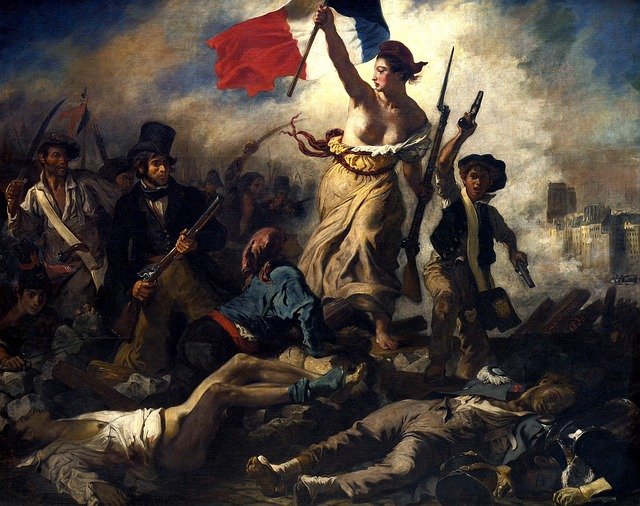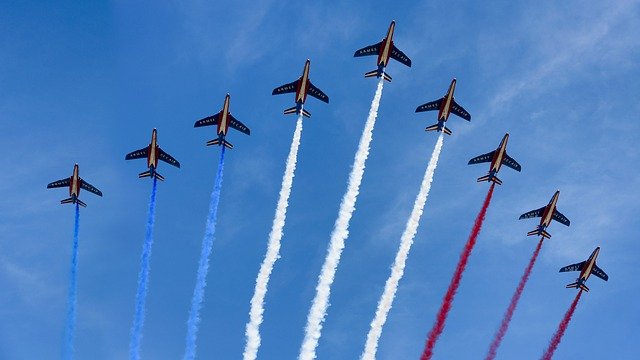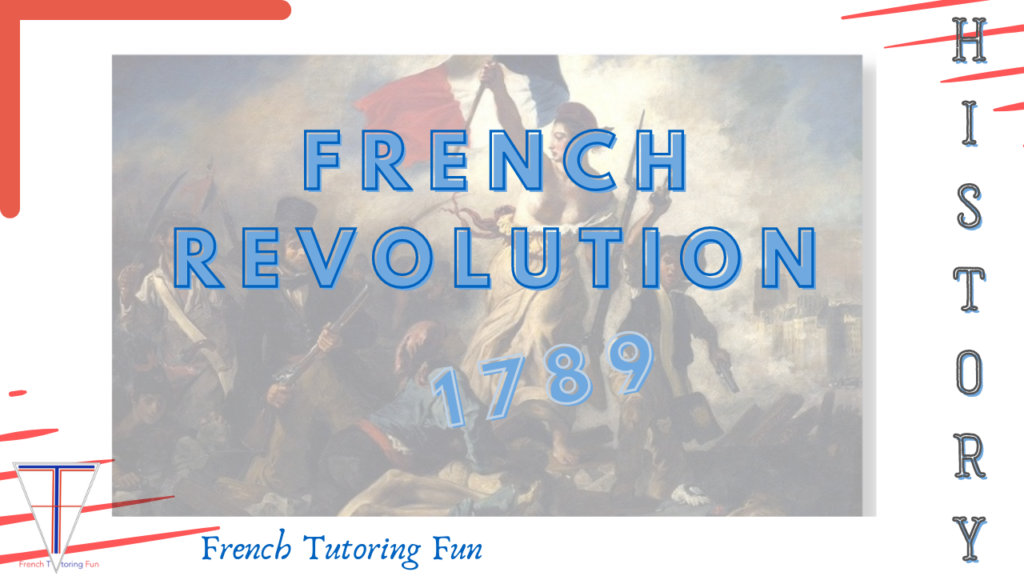
The 14th of July in France is the French National Day, known as “Bastille Day” in other countries, to celebrate the French Revolution. There are many events taking place which we will see together. Behind it, there is a long and complex history, so I have provided you a summary with some details which are important to understand well.
History before and during the French Revolution
To practice your listening, here is a short summary in French!
During the French Revolution (la Révolution Française) the King (le roi) Louis XVI (born in 1754 and died in 1793) reigns in France. The population lives under the Feudal regimes (le régime Féodal), which means that upper classes maintain the control over land. The peasants (les paysans) cultivated these lands (les terres) and the feudal lords gave a part of their harvest to them.
Before the French Revolution, there were already tension between the peasants and the King. Due to floods (les innondations) and drought (la secheresse) the harvest (les récoltes) are a disaster and the price of bread (le prix du pain) has increased by 50 %. Furthermore, peasants have to pay high taxes (les impôts) to nobles, the church and the King. In the meantime in Versailles, nobles receive generous pensions but the kingdom is already bankrupt due to France supporting the American Revolutionary War for the independence with the British people.
In response to this frustration from the nation, the King creates notebooks of grievance (les cahiers de doléances) in which the French people express their complaints. They want to pay less taxes and a removal of privilege to nobles. The King wants to limit his power and end with injustices and inequalities.
On the 20th of June 1789, the King gathers the General Estate (l’Etat Général) divided in third: the Clergy (le Clergé), the Nobles (les Nobles) and the Third State (le Tiers Etat) which is the nation and represents 90% of the population. The King wanted to find new taxes so the nation which is 90% request the Nobles to pay these taxes but they do not want. The nation gathered in a room called “la Salle du Jeu de Paume” where they attested to never separate each other until the creation of a new Constitution.
On the 14th of July 1789, the nation invades the Invalides to get guns. Then, the revolutionary go to the Bastille to find gun powder, but the Bastille is above all a symbol of power, where anyone can be imprisoned at the kings request . They fought for 4 hours and Louis XVI has to accept everything he refused before. This date is important, it is the French National Day (la Fête Nationale).
On the 4th of August 1789, abolition of privileges (l’abolition des privilèges) for Nobles and the feudal rights.
On the 26th of August 1789 : It is the Declaration of the Rights of Man and of Citizens (la Déclaration des Droits de l’Homme et du Citoyen) to have the liberty of opinion, of belief and of expression.
On the 20th of June 1791, the King leaves Paris but he is quickly arrested and brought back in Paris. The King lose the people’s trust.
The deputy in the Assembly wanted the revolution to stop. They voted a decree to acquit the King and get him back in all his functions.
On 17th of July 1791, the Cordeliers called the Parisians to gather on Champs de Mars to sign a petition for the forfeiture of the King. The protest is a disaster. The mayor (le maire) of Paris bring La Fayette and his troops to restore the order. About 50 people died.
Louis XVI has to agree with the Constitution.
On the14th of September 1791, the King attested (prêter serment) in front of the Assembly which leads to the constitutional monarchy (la Monarchie Constitutionnelle) where the King kept some of his power. A new assembly is elected (une nouvelle assemblée est élu) but only by wealthy citizens.
European monarchy do not appreciate this turbulent in France. The 20th of April 1792, the war against the other monarchy is voted with the agreement of the King.
During this war the crowd put a Phrygian cap (un bonnet phrygien), which is the cap of revolutionary, on the head of Louis XVI.
On the 21st of January 1793, the King Louis XVI is executed Place de la Révolution.
Have you heard about the guillotine?
It is Antoine Louis a surgeon who created the guillotine (la guillotine) and not Dr Guillotin. Before the guillotine only nobles were beheaded with an axe or a sword. Poor people were hung or torn apart. Dr Guillotin deputy of the third state suggested this guillotin for equality. Despite of being perceived as negative for us nowadays, the guillotine was an important change for the nation.
During the French revolution, there is also the nationalization of the clergy’s assets which will be debated at the assembly in autumn 1789. The state will now pay the salary of the priests.
The assembly decided without the Pope approval to change the organization of the church. There are now two kind of priests. “The refractory” (Prêtres réfractaires) who do not wish to attest to stay on the side of the Pope and “the Jurat” (Prêtres jureurs)who accepts to attest. Later during the Revolution the refractory priests, will be pursued.
Louis XVI and his family are in prison, this is the end of the constitutional monarchy.
On the 21st of January 1793, the King Louis XVI is executed Place de la Révolution.
Fun fact:
The guillotine used to execute the King was brought in New Caledonia in the village I grew up!
Do you know what the colors of the French flag represent?
It is during the French revolution the French flag (le drapeau Français) was created.
Blue and red represent Paris and white represents the King.
Marseillaise was written in 1792 Rouget de Lisle, a French officer. It is the hymn of freedom which will become the French national anthem.
Allons enfants de la Patrie,
Le jour de gloire est arrivé!
Contre nous de la tyrannie
L’étendard sanglant est levé, (bis)
Entendez-vous dans les campagnes
Mugir ces féroces soldats?
Ils viennent jusque dans vos bras
Égorger vos fils, vos compagnes!
Aux armes, citoyens,
Formez vos bataillons,
Marchons, marchons!
Qu’un sang impur
Abreuve nos sillons!
Que veut cette horde d’esclaves,
De traîtres, de rois conjurés?
Pour qui ces ignobles entraves,
Ces fers dès longtemps préparés? (bis)
Français, pour nous, ah! quel outrage
Quels transports il doit exciter!
C’est nous qu’on ose méditer
De rendre à l’antique esclavage!
Aux armes, citoyens…
Quoi! des cohortes étrangères
Feraient la loi dans nos foyers!
Quoi! Ces phalanges mercenaires
Terrasseraient nos fiers guerriers! (bis)
Grand Dieu! Par des mains enchaînées
Nos fronts sous le joug se ploieraient
De vils despotes deviendraient
Les maîtres de nos destinées!
Aux armes, citoyens…
Tremblez, tyrans et vous perfides
L’opprobre de tous les partis,
Tremblez! vos projets parricides
Vont enfin recevoir leurs prix! (bis)
Tout est soldat pour vous combattre,
S’ils tombent, nos jeunes héros,
La terre en produit de nouveaux,
Contre vous tout prêts à se battre!
Aux armes, citoyens…
Français, en guerriers magnanimes,
Portez ou retenez vos coups!
Épargnez ces tristes victimes,
À regret s’armant contre nous. (bis)
Mais ces despotes sanguinaires,
Mais ces complices de Bouillé,
Tous ces tigres qui, sans pitié,
Déchirent le sein de leur mère!
Aux armes, citoyens…
Amour sacré de la Patrie,
Conduis, soutiens nos bras vengeurs
Liberté, Liberté chérie,
Combats avec tes défenseurs! (bis)
Sous nos drapeaux que la victoire
Accoure à tes mâles accents,
Que tes ennemis expirants
Voient ton triomphe et notre gloire!
Aux armes, citoyens…
(Couplet des enfants)
Nous entrerons dans la carrière
Quand nos aînés n’y seront plus,
Nous y trouverons leur poussière
Et la trace de leurs vertus (bis)
Bien moins jaloux de leur survivre
Que de partager leur cercueil,
Nous aurons le sublime orgueil
De les venger ou de les suivre.
Aux armes, citoyens…
What is organized on the 14th of July to celebrate the French Revolution?
–Military parade = un défilé militaire
There many military parades on the 14th of July in the whole country.
If you are curious, take a look at this full recording of the military parade from 2020.
–Fireworks = les feux d’artifice
–Dance = le bal
People go dancing!
The tradition is that we go dancing at the fire station on the night before the 14th of July.
Here is a teaser of one of them:
What a day look like on the 14th of July?
The 14th of July is a bank holiday in France so we do not go to work.
Most of the shops, museums are closed that day.
Public transports might be available but the timetable may vary.
People watch the military parade on the television. During the day, we do not do much. In the evening, there is a firework display which is always beautiful.

Vive la France!

I really love this article 💙
I learnt alot through this article
Merci beaucoup 💖
Thank you so much Paul!
It is really nice, I appreciate it 🙂